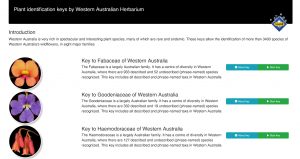
Title: Plant identification keys to Western Australian Plants
Publisher: Western Australian Herbarium
Illustrated: illustrations for each species
Indexed: alphabetical scientific name list per family
Rating: * * * * *
Link: Plant identification keys to Western Australian Plants
The plant identification keys to Western Australian plants were developed by the Western Australian Herbarium.
These identification keys allow users to identify plants in eight major Western Australian plant families (Fabaceae, Goodeniaceae, Haemodoraceae, Lamiaceae, Malvaceae, Proteaceae, Restionaceae and Rutaceae). Together these plant families include more than 3400 species of Western Australia’s wildflowers.
The keys are interactive and allow the user to submit information about the plant they would like to identify in a random order (as opposed to the more traditional dichotomous identification keys. Plants can be identified up to species and subspecies level.
This tool does require some botanical knowledge, as does the identification software, a Lucid key.
For each species in the key there is a basic description, one or more photographs and a distribution map in Western Australia.
Link: Plant identification keys to Western Australian Plants
Keys
Fabaceae of Western Australia
The Fabaceae is a largely Australian family. It has a centre of diversity in Western Australia, where there are 933 described and 52 undescribed (phrase-named) species recognized. This key includes all described and phrase-named taxa in Western Australia.
Goodeniaceae of Western Australia
The Goodeniaceae is a largely Australian family. It has a centre of diversity in Western Australia, where there are 332 described and 19 undescribed (phrase-named) species recognized. This key includes all described and phrase-named taxa in Western Australia.
Haemodoraceae of Western Australia
The Haemodoraceae is a largely Australian family. It has a centre of diversity in Western Australia, where there are 127 described and undescribed (phrase-named) species recognized. This key includes all described and phrase-named taxa in Western Australia.
Lamiaceae of Western Australia
The Lamiaceae a largely Australian family. It has a centre of diversity in Western Australia, where there are 251 described and 24 undescribed (phrase-named) species recognized. This key includes all described and phrase-named taxa in Western Australia.
Malvaceae of Western Australia
The Malvaceae is a largely Australian family. It has a centre of diversity in Western Australia, where there are 381 described and 70 undescribed (phrase-named) species recognized. This key includes all described and phrase-named taxa in Western Australia.
Proteaceae of Western Australia
The Proteaceae is a largely Australian family. It has a centre of diversity in Western Australia, where there are 963 described and 20 undescribed (phrase-named) species recognized. This key includes all described and phrase-named taxa in Western Australia.
Restionaceae of Western Australia
The Restionaceae is a largely Australian family. It has a centre of diversity in Western Australia, where there are 107 described and undescribed (phrase-named) species recognized. This key includes all described and phrase-named taxa in Western Australia.
Rutaceae of Western Australia
The Rutaceae is a largely Australian family. It has a centre of diversity in Western Australia, where there are 198 described and 7 undescribed (phrase-named) species recognized. This key includes all described and phrase-named taxa in Western Australia

